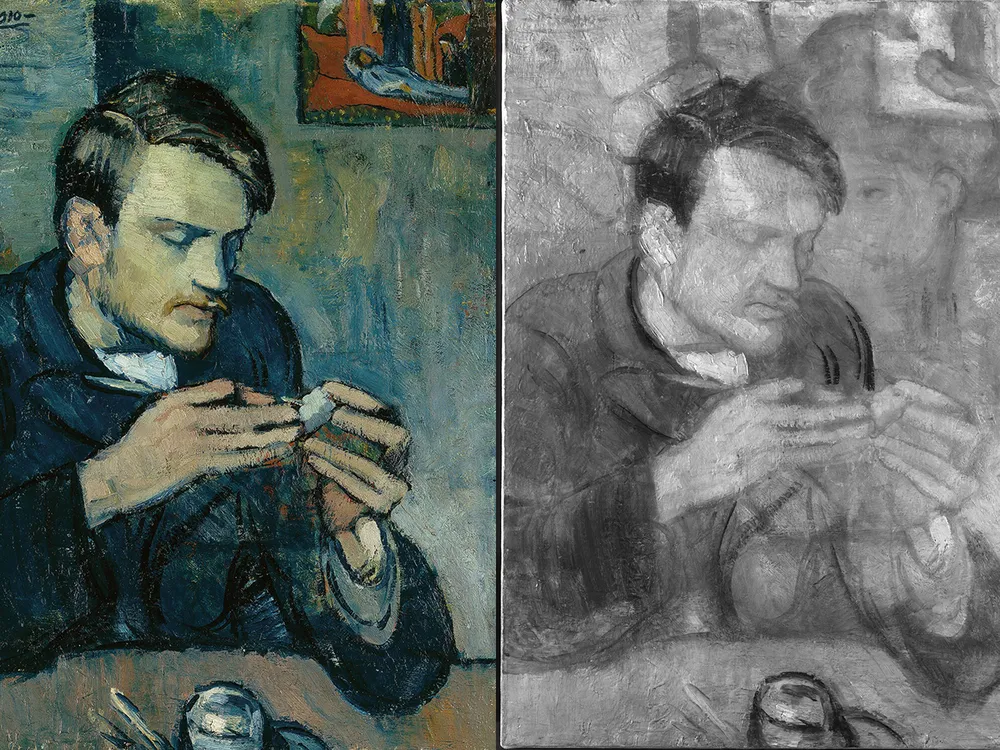See the Hidden Portrait of a Mysterious Woman Discovered Beneath a Picasso Painting
X-ray and infrared imaging has revealed a long-hidden painting beneath “Portrait of Mateu Fernández de Soto,” providing researchers with new insights into the artist’s blue period

Researchers have uncovered a hidden painting beneath Pablo Picasso’s Portrait of Mateu Fernández de Soto, revealing a mysterious woman who had been concealed for more than a century. The discovery sheds new light on the young artist’s creative process and offers a rare glimpse into his early blue period works.
The portrait of the woman, who appears with a chignon hairstyle popular in Paris during the early 1900s, was uncovered by conservators at the Courtauld Institute of Art in London. The discovery comes ahead of the painting’s inclusion in the exhibition “Goya to Impressionism: Masterpieces from the Oskar Reinhart Collection,” which opens at the Courtauld Gallery on February 14.
Barnaby Wright, deputy head of the gallery, tells CNN’s Issy Ronald that the hidden figure emerged gradually as researchers used an infrared camera to scan the surface of the artwork.
“Once you know what’s underneath from this technical image and you take that back to the finished painting, you can see some of those marks very clearly—her eye and her ear and her hair,” he adds.
While the woman’s identity remains a mystery, she shares similar features with other women Picasso painted around this time. According to Wright, she could have been a model, a friend or even a lover.
Portrait of Mateu Fernández de Soto, created in 1901 when Picasso was just 19, depicts his sculptor friend. The artist painted it during his blue period, when his work was dominated by melancholic shades of blue and green—a change that followed the death of his close friend, Carlos Casagemas.
X-ray and infrared scans revealed that Picasso had painted over the woman’s portrait. Like many of his other reworked pieces, the artist painted directly over the older work rather than whitewashing it, as Wright tells CNN.
During this period, Picasso frequently reused canvases due to financial constraints. As Wright says in a statement, “Picasso’s way of working to transform one image into another and to be a stylistic shapeshifter would become a defining feature of his art, which helped to make him one of the giant figures of art history.”
The woman’s portrait sheds new light on the artist’s early years in Paris. Picasso visited the city for the first time in 1900, when he was just beginning to develop his unique style.
While experts acknowledge that the woman’s identity may never be known, they hope the ongoing analysis of the portrait will continue to yield more insights into Picasso’s early techniques and the individuals who inspired him.
The discovery is important because “it shows once again that Picasso, when he reused his supports, incorporated the forms of the underlying composition into the surface painting,” Kenneth Brummel, the co-curator of an exhibition on Picasso’s blue period, tells the Washington Post’s Niha Masih. “In both Portrait of Mateu Fernández de Soto and its underlying composition, the depicted figures rest their elbows on what appears in the infrared image to be a tabletop at the same level.”
Unveiling hidden elements in renowned artworks is becoming increasingly common as technology advances. Also this month, a similar breakthrough revealed a hidden portrait beneath Titian’s Ecce Homo. Conservators have also uncovered hidden works beneath paintings by Vincent van Gogh, Wyndham Lewis and René Magritte.
Picasso’s Portrait of Mateu Fernández de Soto will be displayed alongside other works in “Goya to Impressionism: Masterpieces from the Oskar Reinhart Collection” at the Courtauld Gallery in London from February 14 to May 26.